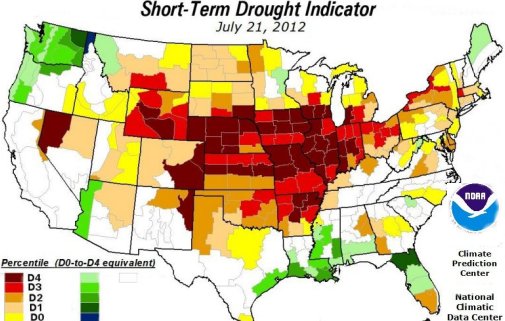Water on Earth
“The Rich
get richer, as the Poor get poorer”
As
the Earth warmed up, the global water cycle speeded up. This
means that, compared to a few years back, more water passes
through each stage of the cycle—evaporation from warmer
oceans, condensation in clouds, rainfall, snowfall, and river
flows. Where it is already wet, the climate becomes wetter,
and floods more frequent; and where it is already dry, the climate
becomes drier, and drought more common. The laws of physics
that govern meteorology anticipate a speedup, but observing
whether it is happening is difficult. (See How the water
cycle kicked into high gear, below.)
Paul Durack and his Australian
team reported1 in Science
that the geographic patterns of salinity in the world’s
oceans are now more pronounced: salty regions became saltier,
and less salty regions became fresher. From their study, they
concluded that the water cycle on Earth accelerated by 8% per
degree of global warming over the 50 years from 1950 to 2000.
The distribution of salt in the ocean was linked to where evaporation
or precipitation had increased; wherever salinity of seawater
increased, the net evaporation had increased, but where salinity
decreased, more rain had fallen recently than before.
Durack also wrote, “the
‘rich get richer’ mechanism is already operating,
with fresh regions becoming fresher and salty regions saltier
in response to observed warming.” The observed speedup
of the water cycle is “double the response projected by
current-generation climate models, and suggests that a substantial
(16 to 24%) intensification of the global water cycle will occur”
in a world that will be 2° to 3°C warmer.
Uncertain availability of
fresh water is a greater risk to human society than is warming
by itself, the authors add. The United States is grappling with
a widespread drought this summer as severe as the historic drought
of the 1950s (story, upper right). The message from climate
scientists may soon be sinking into the nation’s consciousness.
_____________________________________
CITATIONS:
1.
“Ocean
salinities reveal strong global water cycle intensification
during 1950 to 2000” by Paul J. Durack, Susan E. Wijffels,
and R. J. Matear, Science, v. 336,
455 (27 April 2012).
|
Over
55% of USA Now in Drought

The
central Midwest of the United States is experiencing a widespread
but short-term drought, that threatens the nation's supply of
food and animal feed in this growing season. By the third week
of July, some 55% of the land area of the US was in moderate drought
or worse (tan color, above), and the area continues to increase.
The affected area is the greatest since 1956, fifty-six years
ago. On the map, 38% of the nation is in severe drought (category
D2, orange) or worse, and 17% in extreme drought (category D3—red)
or worse. At this writing, all forecasts anticipate that the drought
will continue through this October, according to the US
Seasonal Drought Outlook, of the US Climate Prediction Center.
The
US Department of Agriculture (USDA) reported that 55 percent of
the pasture and rangeland was in poor to very poor condition in
the US. In the Plains and Midwest states, crop losses mounted,
ranchers liquidated herds, and trees continued to drop leaves
and branches. On July 25, the USDA designated even more drought
disaster areas, bringing the total for the 2012 crop year to 1369
counties in 31 states.
And
with more than 40% of US agricultural land now in extreme
or exceptional drought, “Prices of both corn and
soybeans soared to all-time highs, . . with corn climbing more
than 50 percent in the past four weeks alone due to the worsening
drought, squeezing ethanol and livestock producer margins.”
(Reuters, July 20, 2012)
|
|
How water cycle
kicked into high gear
Evaporation of water
increases 7% for every degree C that
water is warmer, according to the laws of physical science.
As the ocean heats up, its molecules speed up, and more
of them leave the ocean surface every second. Driven by
evaporation from the oceans, the entire water cycle speeds
up. Rates of evaporation, condensation of water vapor
into cloud droplets, and precipitation from clouds have
all speeded up since 1950.
As
ocean water evaporates, it leaves behind salt. In the
hot subtropics where the sky is clear, the evaporation
is intense, and the salinity of the ocean, already high,
has increased. But wherever rainfall is abundant, the
salinity has been decreasing – likely because greater
rainfall has diluted the ocean with more fresh water than
before.
It
is important to subtract the precipitation from the evaporation
over oceans, when estimating the global water budget.
The difference—which is called “net evaporation”—does
appear to be increasing globally as the temperature of
the Earth climbs. Precipitation itself seems to increase
more slowly, at about 3% per degree C of warming. |
|
The
first map above assesses the short term drought impacts for about
six months or one growing season. The Drought
Monitor product
of the University of Nebraska at Lincoln, widely used since
2000, attempts to depict both short- and long-term severity and
impacts of drought. Its depiction for the same time (next image,
below), shows areas of extreme (D3) and exceptional
(D4) drought (in red and maroon colors) in Arizona, New Mexico,
and Georgia. The short-term depiction above does not depict such
extreme categories of drought in the three states. A glance at
the long-term drought assessment, next.

|
|
|
|

